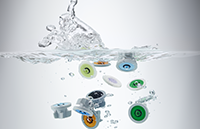Positive eco-balance of a NEOPERL® flow regulator
A flow regulator installed in a shower head saves water and energy when in use. However, how much water and energy is consumed during its production and how much CO2 is emitted during transports? What is the relation between expenditures and savings?
To answer these questions, as part of Markus Berger's doctoral thesis, the Technische Universität Berlin conducted an eco-balance study* commissioned by Neoperl. The investigation provided an astonishing result: If the small flow regulator is in use for ten years, then the resources consumed during the production process are recouped at least 26000 times. In other words, after a few days' use, the production and installation of the flow regulator has already paid off – for humanity and the environment.
Overview of the Results
The production of a NEOPERL® flow regulator consumes 0.12 MJ of primary energy, causes 5.9 g CO2-equivalent GHG emissions, and consumes 30.3 ml of water.
In contrast, the savings achieved by the use of a flow regulator amount to 19231 MJ primary energy, 1223 kg CO2 equivalents and 790 litres of water consumption (as well as 166200 litres of water use).
| Consumption (Production) | Savings (Use) | Positive Factor (Balance) | |
| Primary energy | 0.12 MJ | 19231 MJ | x 160000 |
| CO2 equivalents | 5.9 g | 1223 kg | x 204000 |
| Water consumption | 30.3 ml | 790 l | x 26000 |
The Details of the Scientific Study
The scientific study was conducted by the Technische Universität, Department of Environmental Technology under the supervision of Dr.-Ing. Markus Berger. In calculating the water and energy consumption and the greenhouse gas emissions, the study takes the entire product life cycle of a NEOPERL® SHL-C 2.5 gpm flow regulator into account – from the production of raw materials, to material production, transportation and assembly, on up to its disposal.
Water consumption was calculated under the following assumptions:
- Two-person household
- Each person takes a daily five-minute shower, 300 days per year, calculated over a period of ten years
- Flow rate of 15.0 l/min without a flow regulator, 9.5 l/min with a flow regulator ⇒ results in water savings of 166200 litres over a period of ten years
- Inlet water temperature of 10 °C and a shower temperature of 37 °C
- Specific heat capacity of 4.19 kJ/(kg K) ⇒ 4,831 kWh thermal energy saved
The GaBi6 software from Thinkstep (2014) served as the basis for the calculations. GaBi contains a comprehensive, annually updated database in which the environmental profiles of numerous materials and energy sources are stored.
The eco-balance study was conducted in accordance with ISO 14044. You can find the study online at:
http://link.springer.com/article/10.1007%2Fs13201-015-0328-5
You can find Markus Berger's PhD dissertation here.
* Berger, M.; Söchtig, M.; Weis, C.; Finkbeiner, M., Amount of water needed to save 1 m3 of water: life cycle assessment of a flow regulator. Applied Water Science 2015, in press, DOI: 10.1007/s13201-015-0328-5




